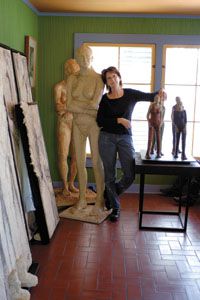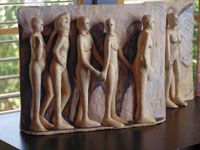 By Wolf Schneider
By Wolf Schneider
Your studio is at your house in Dallas?
Yes. It’s in what used to be the garage, and we added on to it. The part that we added on is screened in to secure all the materials, and we keep it ventilated for all the welding and fumes—lots of fans.
How big is it?
It’s about 30 by 50 feet. And I’ve taken over some of the driveway area too, to work in the open air. I tend to take over everything. [Laughs]
Concrete floors?
Yeah, it’s all concrete. The house and garage were both built in the 1930s. I love working at my house, being able to go out anytime day or night and just work.
I hear you’ve got pots and pans in the studio—but you’re not cooking, right?
No, no. See, I teach bronze casting at Southern Methodist University. And I do a lot of my own bronze casting there. So the pots and pans are where I melt my waxes down. I’m working on all these reliefs that are plaster on wood. I build them up and sometimes I add wax to them. So I’ve got different types of wax and different colors.
Your sculptures are mainly figurative, and some are life-size?
Yeah, a lot are life-size. I’m 5 foot 6, and a lot are exactly my height.
So is your process that you sketch something, then you sculpt it in a small clay or plaster maquette, then a full-size clay or wax piece, then you send it out to be cast?
I cast them myself. I’m hands-on. I want full control. I build clay onto an iron armature. I cast in bronze, or stone, or iron, or multi-mediums. I just did a wood door with copper and iron and two figures.
 You also sometimes clothe the figures, and use acids, stains, and paints, don’t you?
You also sometimes clothe the figures, and use acids, stains, and paints, don’t you?
Mm-hmm. All the figures start out nude. I may cast them twice so I can add clothes.
Nathaniel Hawthorne said, “Moonlight is sculpture.” Frank Zappa said, “Music, in performance, is a type of sculpture. The air in the performance is sculpted into something.” And Tom Stoppard said, “If it hangs on a wall it’s a painting, and if you can walk around it, it’s a sculpture.” Which quote do you relate to most?
Oh, definitely Zappa! I like the concept that music and dance feed into the figurative idea. I disagree with Stoppard—I’d say painters are flat people and sculptors are anything else.
So what area of Dallas are you in?
In the northeast. It’s urban, but we’re on a secluded street.
You grew up there, right?
Yeah. I’m part Choctaw, so all my family on both sides are from Oklahoma.
What do you consider your forte when it comes to sculpting?
I’m really, really knowledgeable about the human form. I love the Renaissance era, Cycladic art, African art, and all of the grave and tomb art. I’m kind of a freak for tombs and graveyards and all that. [Laughs]
At 55 now, what quality have you decided an artist must have, and what quality will only do an artist in?
Art needs to be an obsession—but you need to have a life outside of the studio, too.
What’s your sign, and how much do you relate to it?
Capricorn—I’m always going up the impossible hillside.
What’s the range that your work sells for?
From $300 up to $60,000.
What does an artist need most: a good accountant, a good truck, or a good red wine?
Oh, the last two are the best. [Laughs]
When you reach the end of this incarnation, what sentence would sum it up best for you?
How about: “She worked on what she loved until the end.”
Ballard is represented by Jack Meier Gallery, Houston, TX.
Featured in “My World” June 2006





